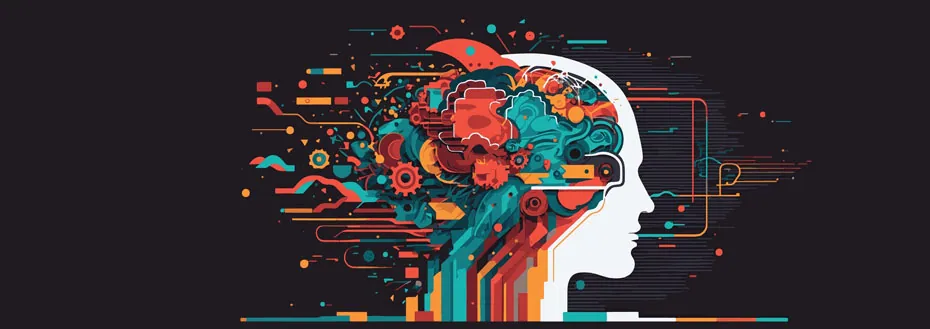Artificial intelligence (AI) has been transformative across different sectors. The capabilities of AI have brought enhanced efficiency and innovation to several industries - from health to finance. One area that has seen this technological change is the creative design industry, which traditionally relied on human creativity and intuition. Incorporation of AI into this field has increased productivity; it has changed the limits of creativity. For executives, knowledge of these advances and how they can be exploited is vital. AI adoption drives business growth and positioning firms at the vanguard of industrial metamorphosis.
The Role of AI in Creative Designing
AI is changing the face of the creative design industry by introducing tools and techniques that improve creativity and productivity. By using AI technologies, designers can create more innovative designs that stretch the boundaries of what is possible. This section explores major AI-powered tools applicable in various design areas.
AI-Powered Tools and Techniques
At present, key AI technologies such as Generative Adversarial Networks (GANs), neural networks, and machine learning algorithms are driving a paradigm shift. GANs, for instance, enable the generation of high-quality images by pitching two neural networks against each other. Many of the tools used by designers today are based on neural networks and machine learning algorithms, which enable more intelligent and adaptable design processes.
Popular AI-driven graphic design tools include DeepArt, which uses neural networks to turn images into artworks inspired by well-known painters, and Adobe Sensei, which incorporates AI into Adobe's suite of creative applications to expedite workflows. RunwayML makes it easier for creatives to experiment with a range of models based on machine learning, thus helping them to inject some level of AI and creativity within their projects.
Practical Applications of AI in the Creative Industry
-
Graphic Design
AI-automated logo generation and intelligent photo editing are finding their way into graphic design. Among the creative design services offered by these tools include image analysis, elements of suggestion to enhance a design, or whole designs generated from user inputs.
-
Animation
When it comes to animation, AI-based motion capture, and animation software have made it possible for animators to create complex animations within a short period. For instance, these tools record human movements and convert them accurately into animated characters.
-
User Interface (UI) Design
For effective UI design, AI-generated layout suggestions and A/B testing techniques are invaluable. With AI, interface layout suggestions can be made that improve user engagement and experience.
-
Automation of Repetitive Tasks
AI is quite good at automating tedious tasks like format conversion, resizing, and color correction. AI relieves designers of these tedious chores, freeing them up to concentrate more on strategic and creative work, which improves the caliber and inventiveness of their output.
Assessing the Real-life Impact of AI in Creative Designing Industry
Let us take, for instance, a company that incorporated AI design tools within its processes. It was found that after integration, there was an increase in productivity of 30% while creativity also increased significantly. At the same time, designers were able to prioritize new creative directions since AI took charge of labor-intensive tasks like image processing or layout adjustment. Through this integration, workflow became smoother and gave space for even better designs that could be considered more innovative.
The creative design sector can achieve increased innovation and efficiency if this potential is fully understood because we are laying the foundation stones for future developments.
Benefits and Opportunities of Integrating AI in Your Design Process
Integration of AI within the domain of creative designing has numerous advantages besides presenting a lot more opportunities than ever before. AI in design is changing how teams work, from better decision-making procedures to cost-effectiveness and scalability. This section explores these advantages in detail.
-
Data-Driven Design Decisions
AI makes use of data analytics to make design decisions that are insightful and serve as a strong base for creativity. AI, in this case, can identify patterns and trends from massive amounts of data, which would have been impossible for humans.
As an example, predictive analysis can establish the desires of consumers by looking at their past actions, social media feeds, or even market information. This helps the designers to create more efficient designs for their clients.
-
Enhanced User Experience (UX)
One thing that AI does well is making sure that user experience is personalized. AI algorithms can analyze user interactions and preferences to tailor experiences for individual users. For example, a fashion brand used AI graphic design tools to personalize its UX design, which resulted in a 25% rise in customer satisfaction and a 40% increase in user engagement. Customizing content with AI also helps brands connect deeply with their audience through designs, thus promoting loyalty and retention levels.
-
Operational Cost Reduction
One of the most significant advantages of artificial intelligence in graphic design is its ability to reduce operational costs. When time-consuming processes like resizing images or color correction are taken care of by the system, designers get extra time to finetune more complex design aspects.
A marketing agency introduced AI tools into their workflow, which led to reduced expenses by 20%. With less cost on operations, companies can reallocate resources efficiently, thereby improving overall profitability.
Challenges and Limitations of Using AI
Even though AI has many advantages for creative design, there are several issues and restrictions that need to be resolved. Careful navigation of ethical considerations and the intricacies of integration and adaptability provide formidable obstacles for designers and corporations.
The risk of reducing human presence in design by using AI art generation methods is quite high. The discussion over the ethical implications and legitimacy of AI-generated content is becoming increasingly heated as it becomes more widely available. Can AI motion graphics truly replicate human designers’ fine touch? Critics argue that an over-reliance on AI could homogenize design and eliminate the distinctive, individual flair that sets human creation apart.
Predictions for the Future on the Use of AI in Graphic Designing
According to experts, AI will keep reshaping the creative design sector by improving the adaptability and intuitiveness of design processes. For example, an AI system specifically designed to co-develop with human experts who provide instant feedback or recommendations during work processes may soon appear. Integrating these cutting-edge AI tools will enable forward-thinking companies to take advantage of new creative opportunities and competitive advantages, which will spur industry innovation.
The Conclusion
AI is changing the creative design industry by opening up new spaces for innovation and efficiency. Top executives must grasp these advancements to remain competitive and forward-thinking. This ranges from automating chores to data-driven decisions and improving user interfaces. It's an essential aspect of incorporating creativity into the workflow as it enhances productivity and encourages uniqueness.
Explore AI solutions to elevate your design processes. Contact us to discover how AI can revolutionize your creative design approach.
Case Studies
-
Flatworld Provided Chart Extraction to a Risk Adjustment Solutions Provider
-
Flatworld Helped a South African Automobile Company With Digital Transformation
-
Flatworld Helped a Leading LA-based Bank to Reduce Client Onboarding Time
-
Flatworld Helped a Healthcare Back-office Service Provider to Broaden Its Services
-
Flatworld Provided RPA Services to a Leading Electronics Solution Provider

USA
Flatworld Solutions
116 Village Blvd, Suite 200, Princeton, NJ 08540
PHILIPPINES
Aeon Towers, J.P. Laurel Avenue, Bajada, Davao 8000
KSS Building, Buhangin Road Cor Olive Street, Davao City 8000


